Diane’s Newsletter 20th March 2018
K is the eleventh letter of the alphabet, and in English it is not used very often (it is actually very low on the scale of use – fifth from the bottom). When I began my research, I discovered that the symbol K comes from the Greek letter kappa, which comes from the Semitic symbol kap – the symbol for an open hand. Semites who had lived in Egypt borrowed the hieroglyph for hand (which begins with D) but changed the D sound to K, seeing as their own word for hand began with K.
Many Greek words were eventually absorbed by Latin and the K became a C. Not only the Romance languages but also the Celtic languages used C in preference to K, and this practice continued into Old English.
In English K is, to my way of looking at it, a rather lazy letter. It manages to do a good job with words like kite, kennel, king and kitten, but when it comes to words like know, knit, knife, knight, knee and knob it grabs first-letter glory only to sit back and let the next letter (in this case, N) do all the hard work.
In other languages, for example, Swedish, the K pulls its own weight, and in words like kniv (knife), knä (knee), knapp (button), the K is pronounced before the N and neither letter is left to do everything on its own.
From a Numerology perspective, K contains much nervous tension. It has the ability to inspire, and it is usually receptive to the feelings of others. It is often very creative and it has the power to achieve its goals, even when they seem unachievable. Its colours are black, white, silver and, occasionally, orange.
Guest Post
 Kenneth G from UK
Kenneth G from UK
Sometimes small, unrelated things we read or hear stay with us. I came across this many years ago and it made quite an impression on me. It may have actually happened, and if so congratulations to British Airways, but even if it didn’t I feel that it is still relevant, more particularly now in the twenty-first century when the main focus seems to be on ‘me’ and not on ‘the other’.
On a British Airways flight from Johannesburg, a middle-aged, well-off white South African lady found herself sitting next to a black man. She called the cabin crew attendant over to complain about her seating.
“What seems to be the problem Madam?” asked the attendant.
“Can’t you see?” she said. “You’ve put me next to a kaffir. I can’t possibly sit next to this disgusting human. Find me another seat!”
“Please calm down Madam.” the stewardess replied. “The flight is very full today, but I’ll see if we have any seats available in business or first class.”
The woman gave a snooty look at the black man beside her, and a few minutes later the stewardess returned with some good news. The lady looked at the people around her with a smug and self satisfied grin.
“Madam, unfortunately, as I suspected, economy is full. I’ve spoken to the cabin services director, and business is also full. However, we do have one seat in first class.”
Before the lady had a chance to answer, the stewardess continued. . .
“It is most extraordinary to make this kind of upgrade, and I had to get special permission from the captain. But, given the circumstances, the captain feels that it is outrageous that anyone should be forced to sit next to such an obnoxious person.”
With that, she turned to the black man sitting next to the woman, and said “So if you’d like to get your things, Sir, I have your seat ready for you. . .”
At which point, many of the surrounding passengers stood and gave a standing ovation while the black gentleman walked up to the front of the plane.
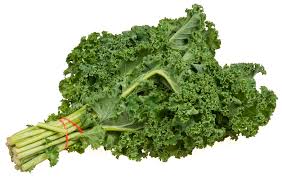 Kale is one the new wonder foods, and there is much written about its ability to help you lose weight, look younger, live longer. . .
Kale is one the new wonder foods, and there is much written about its ability to help you lose weight, look younger, live longer. . .
My initial experience with kale was, however, anything but positive.
Some years back, just as the fascination with kale was beginning to take off, Andris and I attended a short course on raw foods. The woman who led the course was an excited and ardent convert not only to the power of all raw foods but more particularly to the magical qualities of kale. Kale could be eaten for breakfast, lunch and dinner; it could be chopped, sliced, mashed, ground and/or thrown into a mixer and turned into (according to her) the most delicious (and nutritious) of green smoothies.
I had never eaten kale and my greengrocer did not stock it – in fact he was not quite sure what it was. However, he very kindly sourced it for me and the next time I was at his shop he had a whole box of kale for me. I was a little confused: the vegetables in the box resembled flowers dug up from someone’s garden – a medley of greens, blues, yellows and pinks. He assured me that the box contained kale, so I decided to take him at his word, and I took the box home with me.
Of course, the kale in the box was the decorative kind – but I didn’t realize that. We ate steamed kale and kale in salads and kale in smoothies and all the while we wondered at the strange taste but kept telling ourselves that it was going to do us lots of good.
 Then I happened to see a photo of proper kale and after some time online, googling the word kale, I understood that what we had been eating was not actually what we should have been eating. Fortunately decorative kale does not kill you (or else I would not be here writing about it), but it is not particularly pleasant to eat.
Then I happened to see a photo of proper kale and after some time online, googling the word kale, I understood that what we had been eating was not actually what we should have been eating. Fortunately decorative kale does not kill you (or else I would not be here writing about it), but it is not particularly pleasant to eat.
We did eventually try the proper stuff, but by then I think my taste buds had lost interest. For those of you who want to take the plunge, make sure that you start off with the right kind of kale and not the kale that borders your flower garden.
Images from Wikimedia and Pixabay
Kathmandu
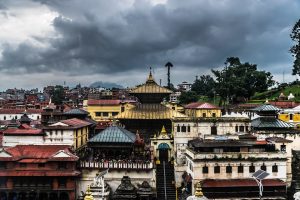 Of course Kathmandu begins with K so it makes sense that it could be included in a Newsletter governed by the letter K. But there are lots of other places that begin with K: Kalca, Kaunas, Kalgoorlie, Kaliningrad, Kansas City. . . so why choose Kathmandu?
Of course Kathmandu begins with K so it makes sense that it could be included in a Newsletter governed by the letter K. But there are lots of other places that begin with K: Kalca, Kaunas, Kalgoorlie, Kaliningrad, Kansas City. . . so why choose Kathmandu?
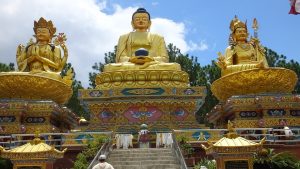
Why not?
Most of you probably know that Kathmandu is situated in Nepal at 1,400 metres above sea level and is surrounded by four major mountains. Apart from having both the highest mountain and the highest lake in the world, it is also the capital, and greater Kathmandu is home to about five million people, most of them followers of Hinduism. Roughly one fifth of the population is Buddhist.
The name of the city comes from Kasthamandap (a combination of two Sanskrit words: Kāṣṭha (काष्ठ) meaning wood and Maṇḍap (/मण्डप) meaning covered shelter), which was actually the name of a temple. The temple, a two-storey building built at the end of the sixteenth century entirely of wood with no nails, was unfortunately destroyed in an earthquake in April 2015.
The city has other names as well: great city, city of glory and city of light. Although the present name hails from the sixteenth century there is evidence that people have lived in the area since around 100 AD, and it may be interesting to know that, in spite of its longevity and unlike neighbours China and India, Nepal has never been ruled by a foreign power.
There are two things to be aware of if you are intending to visit Kathmandu. People do not shake hands – instead they place their palms together and bow, saying Namaste (I salute the God in you). Also, touching anything with your feet is considered extremely offensive.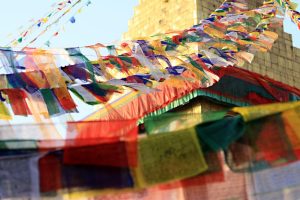
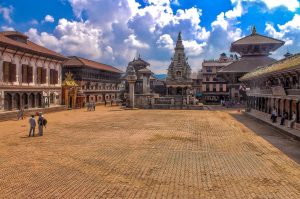
In spite of the high mountains and lakes (or possibly because of), Kathmandu has one of the slowest internet speeds in the world: 256 kbps. To put this into perspective, here are some average internet speeds around the globe: South Korea, 28.6Mbps; Sweden, 22.5Mbps; United States, 18.7Mbps; Romania, 13.2Mbps; Thailand, 9.3Mbps; Australia, 8.6Mbps. . .
Kathmandu has had World Heritage status since 1979 partly because of its more than 100 significant monuments and pilgrimage sites.
Kidney Bean Curry
3 dessertspoons vegetable oil (I use Sunflower)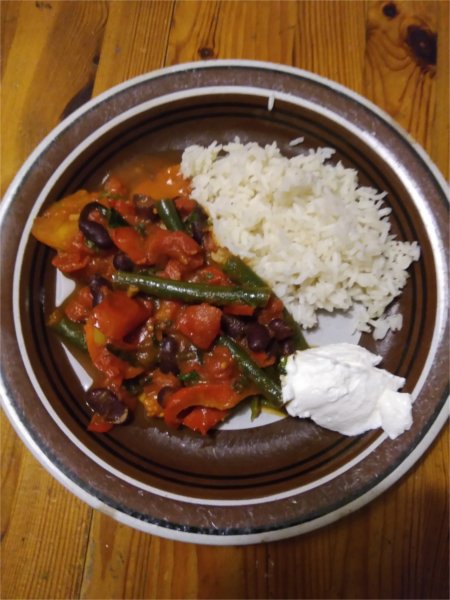
2-3 shallots or 1 small onion, chopped
2 cloves garlic
1 red capsicum chopped
1 teaspoon coriander
1 teaspoon cummin
1 teaspoon garam masala
1 teaspoon tumeric
1/4 teaspoon cayenne pepper
1/2 teaspoon curry powder
1 teaspoon herb salt or ordinary salt
1 medium tomato, peeled and chopped
1 medium carrot, peeled and chopped
150g green beans topped, tailed and chopped
1 tin kidney beans (400g) or 400g pre-cooked kidney beans
1 tin tomatoes or tomato passata (400g)
1 cup water
In a saucepan, heat the oil. Add the shallots/onion, the garlic and the capsicum. Add the spices. Cook on low for a few minutes until fragrant.
Add the vegetables, the beans, the tomatoes/passata and as much of the water as is needed to make a thick sauce.
Let simmer, covered, until the vegetables are soft.
Adjust the seasoning if necessary.
Garnish with fresh coriander (optional)
Serve with rice and plain yoghurt